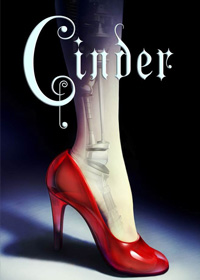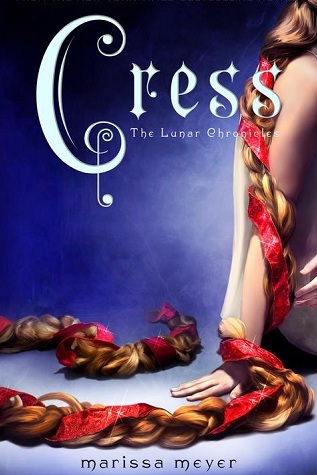Marissa Meyer’s Lunar Chronicle series will always hold a special place in my heart. Cinder was published during my first year of my PhD, and was one of the first books I selected for my exegesis on science fiction in young adult literature. I presented a paper on it in 2014 entitled “Future Human: the body in M.T Anderson’s Feed and Marissa Meyer’s Cinder” at the NewMac Conference, Newcastle, and the novel is the focus of a chapter I’ve submitted for potential publication in the hopefully not too distant future. In my exegesis, I examined how Cinder represents technology and the posthuman other (especially with Cinder herself and the android character, Iko). Scarlet and Cress came out in 2013 and 2014 respectively, and Winter in 2015, when I finally submitted and passed my PhD. So, academically, this series means a lot to me.
As part of Erin’s Book Challenge, I chose Winter as one of my ten novels, however, it meant I had to wait until the 1st of January to read, which kind of sucked, but also increased the anticipation as I’ve had the book on my desk for months now, all 800+ pages begging to be read. Yesterday afternoon I turned the final page and all those lovely gooey emotions (satisfaction, glee, sorrow for a good series forever finished) made my head pleasantly buzz. It also signalled an end to an all consuming part of my life: Cinder was there when I began my PhD and Winter (the name quite fitting) at the end. But let’s start at the beginning.
The Lunar Chronicles takes some traditional fairytale stories and adds a brilliant SF twist. “Cinderella”, “Little Red Riding Hood”, “Rapunzel”, and “Snow White” are used as skeletons on which Meyer builds a rich and epic narrative involving mind-reading evolved humans from the moon, cute androids, and heartbreaking plague. Each novel is named after its female protagonist.
Cinder follows the journey of a cyborg mechanic Cinderella, Cinder, who is abused by her stepmother and struggles with her identity having no memories from before she was twelve. She meets Prince Kai when he seeks her expertise in fixing his android, keeping secret her cyborg nature, and they instantly form a connection. Meanwhile, Queen Levana, the evil Lunar queen and a formidable opponent with the ability to ‘glamour’ and control others’ minds, sets her sights on the prince. As the series villain, Queen Levana rolls all the evil stepmothers and queens together to form one nasty woman (and, besides “Little Red Riding Hood”, all the fairytales Meyer gathers inspiration from have a woman as the villain). Things quickly pick up pace when someone close to Cinder becomes infected with the plague and her stepmother forcibly donates her body towards finding a cure, a process that kills the subject. During the testing, it’s revealed that she’s immune and the secrets of her past begin to come to light. Like any good heroine in a fairytale, she must go head to head with the evil queen in the hopes of winning her true love, but the story doesn’t end where you expect. Bring on book two!
Scarlet, obviously, is based on the tale of “Little Red Riding Hood” and the heroine is feisty and brave, and determined to find her missing grandmother. Calling back to some of the more darker versions of the traditional tale where the wolf represents male sexuality (and I highly recommend “The Company of Wolves” by Angela Carter in her collection The Bloody Chamber is a must read), Scarlet meets her match with the man known as Wolf, who sometimes acts more beast than man, and the two of them set off to find her grandmother. Yet Wolf isn’t who he pretends to be, and Scarlet later regrets trusting him when everything she thought she knew is questioned. Right, I’m doing my best to avoid spoilers so my descriptions are only going to become more vague.
Book three, Cress, echoes the story of Rapunzel in which Cress has been locked away inside a satellite where she carries out surveillance on Earth on behalf of the Lunar queen. Socially isolated, all she has learnt has come from television dramas and newscasts, so when she’s rescued by the dashing, roguish Captain Thorne, she crushes hard. I particularly loved this book as I wasn’t as familiar with the Rapunzel tale and I’d forgotten a lot of the key events (for example, what happens to Thorne) so I got a real kick when I made the connections. So Cinder, Scarlet and Cress join forces to rescue Prince Kai from the evil clutches of Queen Levana, but again, things don’t quite go to plan.
The final book, Winter, introduces us more closely with the Snow White character, Winter, who is the stepdaughter of Queen Levana. She’s a Lunar and has the same ability to manipulate others, yet choses not to and, as a result, hallucinates frequently. She’s naturally beautiful and the Lunar people love her, which encourages Queen Levana’s ire. Her guard, Jacin Clay, is devoted to her so you can imagine his heartbreak when he’s order by the queen to kill her, just like in the fairytale (sorry if you think this is a spoiler, but really, if you’ve read this far you’ve hopefully picked up the close connection Meyer’s books have with the traditional stories). This book is huge compared to the other novels in this series, which did make it dangerous when reading on my back with the book held up above my face, and a lot goes on. It’s well written though, so you’re never really confused or lost despite the constant switching between characters, the moments chosen well to avoid losing the narrative pace.
From the very first book, Meyer switches from character to character, slowly building on the cast and each name is purposefully chosen in honour of the traditional stories: Thorne’s name is inspired by the thorns at the bottom of Rapunzel’s tower, and Cress (although short for Crescent Moon) is, like Rapunzel (and rampion), a kind of salad green, which, in the traditional tale, Rapunzel’s father steals from the witches garden for his pregnant wife. There are symbols scattered throughout all the books, and it was fun making the connections. Having studied the previous novels, especially Cinder, quite closely, I couldn’t help thinking about how I could write another paper as I was reading Winter and, even though I’ve finished my PhD, I’m keen to write something academic about the series as a whole. Who knows what 2016 will bring, so maybe I will. Either way, this is a series that I will return to again and again.




